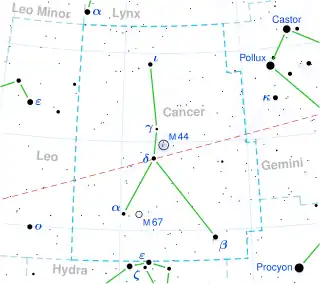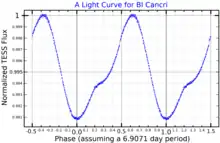 | |
| Observation data Epoch J2000.0 Equinox J2000.0 | |
|---|---|
| Constellation | Cancer |
| Right ascension | 08h 44m 45.03571s[1] |
| Declination | +10° 04′ 54.0073″[1] |
| Apparent magnitude (V) | 5.58 - 5.71[2] |
| Characteristics | |
| Evolutionary stage | Main sequence |
| Spectral type | A1VpHgMnSiEu[3] |
| B−V color index | −0.069[4] |
| Variable type | α2 CVn[2] |
| Astrometry | |
| Radial velocity (Rv) | +27.50[5] km/s |
| Proper motion (μ) | RA: −14.686[1] mas/yr Dec.: −18.466[1] mas/yr |
| Parallax (π) | 6.5062 ± 0.0748 mas[1] |
| Distance | 501 ± 6 ly (154 ± 2 pc) |
| Absolute magnitude (MV) | +0.07[4] |
| Details | |
| Mass | 3.011[6] M☉ |
| Radius | 2.909[6] R☉ |
| Luminosity | 102[7] L☉ |
| Surface gravity (log g) | 3.964[6] cgs |
| Temperature | 10,615[6] K |
| Metallicity [Fe/H] | +0.013[6] dex |
| Rotation | 6.907 d[7] |
| Rotational velocity (v sin i) | 21[7] km/s |
| Age | 263[8] Myr |
| Other designations | |
| Database references | |
| SIMBAD | data |
49 Cancri is a single star[10] in the zodiac constellation of Cancer, located 501 light years away from the Sun. It has the Bayer designation b Cancri; 49 Cancri is the Flamsteed designation. It is visible to the naked eye as a faint star with an apparent visual magnitude of about 5.6. It is moving away from the Earth with a heliocentric radial velocity of +27.5 km/s.

49 Cancri is a variable star. Its brightness changes from magnitude 5.58 to 5.71 every seven days. It is classified as an α2 Canum Venaticorum variable, a class of magnetic chemically peculiar stars. The brightness changes are thought to correspond to the rotation of the star. 49 Cancri is classified from its spectrum as an Ap star, with enhanced lines of silicon, europium, and chromium.[12] Additionally, calcium and magnesium lines are described as weaker than normal.[3]
49 Cancri is classified as an A1 main sequence star.[3] It has three times the mass of the Sun, an effective temperature of 10,615 K, and a radius of 2.9 R☉.[6] It radiates about a hundred times the luminosity of the Sun due to its high temperature and large size.[7]
References
- 1 2 3 4 5 Vallenari, A.; et al. (Gaia collaboration) (2023). "Gaia Data Release 3. Summary of the content and survey properties". Astronomy and Astrophysics. 674: A1. arXiv:2208.00211. Bibcode:2023A&A...674A...1G. doi:10.1051/0004-6361/202243940. S2CID 244398875. Gaia DR3 record for this source at VizieR.
- 1 2 Samus, N. N.; Durlevich, O. V.; et al. (2009). "VizieR Online Data Catalog: General Catalogue of Variable Stars (Samus+ 2007-2013)". VizieR On-line Data Catalog: B/GCVS. Originally Published in: 2009yCat....102025S. 1: B/gcvs. Bibcode:2009yCat....102025S.
- 1 2 3 Abt, Helmut A.; Morrell, Nidia I. (1995). "The Relation between Rotational Velocities and Spectral Peculiarities among A-Type Stars". The Astrophysical Journal Supplement Series. 99: 135. Bibcode:1995ApJS...99..135A. doi:10.1086/192182.
- 1 2 Anderson, E.; Francis, Ch. (2012). "XHIP: An extended hipparcos compilation". Astronomy Letters. 38 (5): 331. arXiv:1108.4971. Bibcode:2012AstL...38..331A. doi:10.1134/S1063773712050015. S2CID 119257644.
- ↑ Gontcharov, G. A. (2006). "Pulkovo Compilation of Radial Velocities for 35 495 Hipparcos stars in a common system". Astronomy Letters. 32 (11): 759–771. arXiv:1606.08053. Bibcode:2006AstL...32..759G. doi:10.1134/S1063773706110065. S2CID 119231169.
- 1 2 3 4 5 6 Huber, Daniel; Bryson, Stephen T.; Haas, Michael R.; Barclay, Thomas; Barentsen, Geert; Howell, Steve B.; Sharma, Sanjib; Stello, Dennis; Thompson, Susan E. (2016). "The K2 Ecliptic Plane Input Catalog (EPIC) and Stellar Classifications of 138,600 Targets in Campaigns 1-8". The Astrophysical Journal Supplement Series. 224 (1): 2. arXiv:1512.02643. Bibcode:2016ApJS..224....2H. doi:10.3847/0067-0049/224/1/2. S2CID 118621218.
- 1 2 3 4 Netopil, Martin; Paunzen, Ernst; Hümmerich, Stefan; Bernhard, Klaus (2017). "An investigation of the rotational properties of magnetic chemically peculiar stars". Monthly Notices of the Royal Astronomical Society. 468 (3): 2745. arXiv:1703.05218. Bibcode:2017MNRAS.468.2745N. doi:10.1093/mnras/stx674. S2CID 119215348.
- ↑ Kochukhov, O.; Bagnulo, S. (2006). "Evolutionary state of magnetic chemically peculiar stars". Astronomy and Astrophysics. 450 (2): 763. arXiv:astro-ph/0601461. Bibcode:2006A&A...450..763K. doi:10.1051/0004-6361:20054596. S2CID 18596834.
- ↑ "49 Cnc". SIMBAD. Centre de données astronomiques de Strasbourg. Retrieved 2019-07-29.
- ↑ Eggleton, P. P.; Tokovinin, A. A. (2008). "A catalogue of multiplicity among bright stellar systems". Monthly Notices of the Royal Astronomical Society. 389 (2): 869. arXiv:0806.2878. Bibcode:2008MNRAS.389..869E. doi:10.1111/j.1365-2966.2008.13596.x. S2CID 14878976.
- ↑ "MAST: Barbara A. Mikulski Archive for Space Telescopes". Space Telescope Science Institute. Retrieved 7 January 2023.
- ↑ Renson, P.; Manfroid, J. (2009). "Catalogue of Ap, HGMN and Am stars". Astronomy and Astrophysics. 498 (3): 961. Bibcode:2009A&A...498..961R. doi:10.1051/0004-6361/200810788.